Dobrova pri Prihovi
Dobrova pri Prihovi (pronounced [ˈdoːbɾɔʋa pɾi ˈpɾiːxɔʋi]) is a small settlement in the Municipality of Oplotnica in eastern Slovenia. Traditionally the area was part of the Styria region. It is now included in the Drava Statistical Region.[2]
Dobrova pri Prihovi Dobrova (until 1998) | |
|---|---|
 Dobrova pri Prihovi Location in Slovenia | |
| Coordinates: 46°21′49.26″N 15°28′18.37″E | |
| Country | |
| Traditional region | Styria |
| Statistical region | Drava |
| Municipality | Oplotnica |
| Area | |
| • Total | 1.28 km2 (0.49 sq mi) |
| Elevation | 316.3 m (1,037.7 ft) |
| Population (2015)[1] | |
| • Total | 48 |
Name
The settlement was named Dobrova until 1998, when it was renamed Dobrova pri Prihovi (literally, 'Dobrova near Prihova') to differentiate it from other settlements with the same name.[1] The name Dobrova is shared with several other places in Slovenia and is derived from Common Slavic *dǫbrova 'place where there is a deciduous or oak forest', in turn derived from *dǫbъ 'deciduous tree, oak'. Like similar names (e.g., Dobrovce, Dobrovnik, Zadobrova), it originally referred to the local vegetation.[3]
gollark: I can write some code for this if desisred.
gollark: Surely you can just pull a particular tag of the container.
gollark: I can come up with a thing to transmit ubqmachine™ details to osmarks.net or whatever which people can embed in their code.
gollark: It's an x86-64 system using debian or something.
gollark: > `import hashlib`Hashlib is still important!> `for entry, ubq323 in {**globals(), **__builtins__, **sys.__dict__, **locals(), CONSTANT: Entry()}.items():`Iterate over a bunch of things. I think only the builtins and globals are actually used.The stuff under here using `blake2s` stuff is actually written to be ridiculously unportable, to hinder analysis. This caused issues when trying to run it, so I had to hackily patch in the `/local` thing a few minutes before the deadline.> `for PyObject in gc.get_objects():`When I found out that you could iterate over all objects ever, this had to be incorporated somehow. This actually just looks for some random `os` function, and when it finds it loads the obfuscated code.> `F, G, H, I = typing(lookup[7]), typing(lookup[8]), __import__("functools"), lambda h, i, *a: F(G(h, i))`This is just a convoluted way to define `enumerate(range))` in one nice function.> `print(len(lookup), lookup[3], typing(lookup[3])) #`This is what actually loads the obfuscated stuff. I think.> `class int(typing(lookup[0])):`Here we subclass `complex`. `complex` is used for 2D coordinates within the thing, so I added some helper methods, such as `__iter__`, allowing unpacking of complex numbers into real and imaginary parts, `abs`, which generates a complex number a+ai, and `ℝ`, which provvides the floored real parts of two things.> `class Mаtrix:`This is where the magic happens. It actually uses unicode homoglyphs again, for purposes.> `self = typing("dab7d4733079c8be454e64192ce9d20a91571da25fc443249fc0be859b227e5d")`> `rows = gc`I forgot what exactly the `typing` call is looking up, but these aren't used for anything but making the fake type annotations work.> `def __init__(rows: self, self: rows):`This slightly nonidiomatic function simply initializes the matrix's internals from the 2D array used for inputs.> `if 1 > (typing(lookup[1]) in dir(self)):`A convoluted way to get whether something has `__iter__` or not.
References
- Statistical Office of the Republic of Slovenia: Dobrova pri Prihovi.
- Oplotnica municipal site
- Snoj, Marko (2009). Etimološki slovar slovenskih zemljepisnih imen. Ljubljana: Modrijan. p. 114.
External links
This article is issued from Wikipedia. The text is licensed under Creative Commons - Attribution - Sharealike. Additional terms may apply for the media files.
